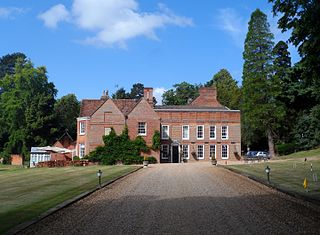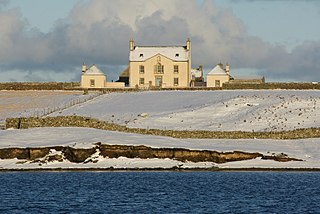
Addington Palace is an 18th-century mansion in Addington near Croydon in south London, within the historic county of Surrey. It was built on the site of a 16th-century manor house. It is particularly known for having been, between 1807 and 1897, the summer residence of the Archbishops of Canterbury. Between 1953 and 1996 it was occupied by the Royal School of Church Music. It is now a conference and wedding venue and country club, while the grounds are occupied by a golf course.

Buckminster is a village and civil parish within the Melton district of Leicestershire, England, which includes the two villages of Buckminster and Sewstern. The total population of the civil parish was 356 at the 2011 census. It is on the B676 road, 10 miles east of Melton Mowbray and 4 miles west of the A1 at Colsterworth.

A manor house was historically the main residence of the lord of the manor. The house formed the administrative centre of a manor in the European feudal system; within its great hall were held the lord's manorial courts, communal meals with manorial tenants and great banquets. The term is today loosely applied to various country houses, frequently dating from the Late Middle Ages, which formerly housed the landed gentry.

Ostankino Palace is a former summer residence and private opera theatre of Sheremetev family, originally situated several kilometres to the north from Moscow but now a part of the North-Eastern Administrative Okrug of Moscow. Extant historical Ostankino includes the main wooden palace, built in 1792–1798 around a theater hall, with adjacent Egyptian and Italian pavilions, a 17th-century Trinity church, and fragments of the old Ostankino park with a replica of Milovzor folly.

Iford Manor is a manor house in Wiltshire, England. It is a Grade II* listed building sitting on the steep, south-facing slope of the Frome valley, in Westwood parish, about 2 miles (3.2 km) southwest of the town of Bradford-on-Avon. Its Grade I registered gardens are open to the public from April to September each year.

The Grange is a historic Georgian manor in downtown Toronto, Ontario. It was the first home of the Art Museum of Toronto. Today, it is part of the Art Gallery of Ontario.

Muchalls Castle stands overlooking the North Sea in the countryside of Kincardine and Mearns, Aberdeenshire, Scotland. The lower course is a well-preserved Romanesque, double-groined 13th-century tower house structure, built by the Frasers of Muchalls. Upon this structure, the 17th-century castle was begun by Alexander Burnett of Leys and completed by his son, Sir Thomas Burnett, 1st Baronet, in 1627. The Burnetts of Leys built the remaining four-storey present-day castle.

Murrintown, also spelled Murntown, is a small village located in the southeast of County Wexford, in Ireland, close to Wexford town. It is part of the parish of Piercestown.

The Elkins Estate is an American 42-acre (170,000 m2) estate located in Elkins Park, Montgomery County, Pennsylvania. The estate contains seven buildings, the most notable being Elstowe Manor and Chelten House, mansions designed by Horace Trumbauer.

Widford is an area of Chelmsford and former civil parish, now in the unparished area of Chelmsford, in the Chelmsford district, in the county of Essex, England. It is approximately 1.5 miles (2.4 km) south-south-west of the city's railway station. It encloses a mixed residential, industrial and rural area south of the River Can, east of the River Wid and mostly to the west of the Great Eastern Main Line. In 1931 the parish had a population of 457.

Kincardine Castle is a Victorian country house in Royal Deeside, Scotland. Formerly known as Kincardine House, it is a private home of Andrew Bradford and also operates as a hospitality venue. The house sits 1 kilometre (0.62 mi) north-east of the village of Kincardine O'Neil, and 8 kilometres (5.0 mi) east of Aboyne on the north side of the River Dee, Aberdeenshire.

Castle Forbes is a 19th-century country house in the Scottish baronial architecture style near Alford in Aberdeenshire, Scotland.

Dinmore Manor House is a large rural house in a well-wooded, hilly part of Herefordshire in the least populous parish of the county, Dinmore. It was substantially rebuilt in late 16th century, altered around 1830 and extended around the year 1928. The main house is a Grade II listed building. The outlying chapel is mostly medieval and is grade II* listed.

Flitwick Manor is a Georgian country house in the south of Flitwick, Bedfordshire, England. It is located on Church Road off the A5120 road. Now operating as a hotel, the manor is a Grade II* listed building. Now owned by Flitwick Town Council, much of the Grade II Register of Historic Parks and Gardens listed park is accessible to the public.

Preston Manor is the former manor house of the ancient Sussex village of Preston, now part of the coastal city of Brighton and Hove, England. The present building dates mostly from 1738, when Lord of the manor Thomas Western rebuilt the original 13th-century structure, and 1905 when Charles Stanley Peach's renovation and enlargement gave the house its current appearance. The manor house passed through several owners, including the Stanfords—reputedly the richest family in Sussex—after several centuries of ownership by the Diocese of Chichester and a period in which it was Crown property.

Swakeleys House is a Grade I-listed 17th-century mansion in Ickenham, London Borough of Hillingdon, built in 1638 for the future Lord Mayor of London, Sir Edmund Wright. Originally the home of the lords of the manor of Swakeleys, writer Samuel Pepys visited the house twice. The property changed hands many times over the years and at one time was home to the Foreign & Commonwealth Office Sports Association. Large sections of the grounds were sold off in 1922 and developed as suburban housing.

Belmont House is a Georgian country house on the island of Unst, the most northerly of the Shetland Islands, Scotland. It was constructed in 1775 by Shetland landowner Thomas Mouat of Garth, and has been described as "possibly the most ambitious, least-altered classical mansion in the Northern Isles." The house was restored from a derelict state between 1996 and 2010 by the Belmont Trust. The house is now used as a self catering holiday house and venue for events. It is protected as a category A listed building, and the grounds are included on the Inventory of Gardens and Designed Landscapes in Scotland, the national listing of significant gardens.

Dogmersfield Park or Dogmersfield House is a Grade I listed Georgian country house, now being used as a hotel. It is located in Dogmersfield, a small village in Hampshire, England. The land was recorded in the Domesday Book of 1086 as "Doccemere feld".

Ampney Park is a 16th century manor house at Ampney Crucis, Gloucestershire, England. It is a Grade II listed building.




















